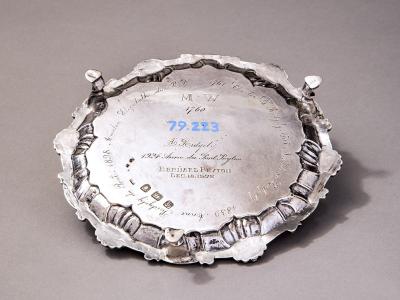Salver
London
1761-1762
Maker
Richard Rugg (mark entered 1754)
Measurements
1 in x 6 1/2 in
Materials
Silver
Credit Line
Historic Odessa Foundation, gift of Mrs. Bernard Peyton
Accession Number
1979.223
Inscription
Four maker hallmarks, including date letter “F,” are stamped in a line on the bottom. “1761 Charles G. Ridgely, 1785 Nicholas Ridgely, 1830 Anne Ridgely du Pont, 1898. Amélia Elizabeth du Pont.”; “M.W / 1760”; “A Ridgely”; “1924 Anne du Pont Peyton”; and “Bernard Peyton / Dec. 18, 1875” are all engraved at different times on the bottom.
Provenance
Based on the names engraved on the outside bottom, the salver descended from Mary Wynkoop (1746–1772) and her husband Charles Greenberry Ridgely (1738–1785) to Nicholas Ridgely (1762–1830) to Anne Ridgely du Pont (1815–1898) to Amélia Elizabeth du Pont (1842–1917) to Anne Ridgely du Pont de Nemours Peyton (1867–1944) to Bernard Peyton (1896–1976) to the donor. Except for reference to Mary Wynkoop, the provenance is the same as the tankard (acc. no. 1980.108).
The salver provenance from the mid-19th century to the present parallels that of other silver in the Historic Odessa collection, accession numbers 1979.222.1-.4, 1979.224, and 1980.108.
Comments
This elegant salver, also called a waiter, was made by Richard Rugg, who seems to have specialized in salvers, as did his contemporary Robert Rew (mark entered 1754), to whom the salver was previously attributed. Used underneath tea- and coffeepots, they protected teatable tops from drips; they held sweetmeats and other delicacies; or they may have accumulated used spoons.
The history of ownership detailed by the inscriptions begins with Mary Wynkoop, who married Charles Greenberry Ridgely in 1761, about the same time the salver was made. The 1760 date below Mary's initials was added later. If it has historical meaning, that meaning is lost.
Bibliography
Zimmerman, A Storied Past, 208-209.

